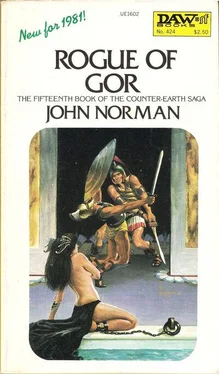When it had become clear, incidentally, that Ar had, for most practical purposes, spared Lara, the troops of Lara, not bothering to join with those of Port Olni and Ti, had returned to their city. There would now be sentiment in Lara favoring Ar. This would give Ar political leverage at the confluence of the Olni and Vosk, a strategic point if Cos should ever choose to move in force eastward along the Vosk. Lara was the pivot between the Salerian Confederation and the Vosk towns.
“Hurry!” called the guardsman.
I lifted my hand, acknowledging that I had heard him, and continued my pace toward the wharves of Fina.
For several weeks I had moved from one river town to the next, examining slave markets and attempting to obtain information on the whereabouts of the pirate, Kliomenes. Understandably I encountered few willing informants. Many people, I was sure, knew more of this fellow than they admitted. His name, and that of his captain, Policrates, were apparently feared on the river. These river pirates were not, it must be understood, a few scattered crews of cutthroats. Various bands had their own strongholds and ships. It was not unusual that a single captain had as many as three or four hundred men and eight to ten ships. Similarly there were relationships among these bands, divisions of territory and alliances. They were a power on the river.
I stepped aside to let a free woman, veiled, and a child pass.
I had gone from Lara to White Water, using the barge canal, to circumvent the rapids, and from thence to Tancred’s Landing. I had later voyaged downriver to Iskander, Forestport, and Ar’s Station. Ar’s Station, incidentally, is near the site where there was a gathering, several years ago, of the horde of Pa-Kur, of the Caste of Assassins, who was leading an alliance of twelve cities, augmented by mercenaries and assassins, against the city of Ar.
This war is celebrated, incidentally, in the Gorean fashion, in several songs. Perhaps most famous among them are the songs of Tarl of Bristol. The action is reputed to have taken place in 10,110 C.A., Contasta Ar, from the Founding of Ar. It was now, in that chronology, the year 10,127.
Ar’s Station, incidentally, did not exist at the time of the massing of the horde of Pa-Kur. It was established four years afterward, as an outpost and trading station, on the south bank of the Vosk. It also commands, in effect, the northern terminus of one of the great roads, the Viktel Aria, or Ar’s Triumph, leading toward Ar. This is also the road popularly known as the Vosk Road, particularly by those viewing it from a riverward direction.
West of Ar’s Station on the river I had visited Jort’s Ferry, Point Alfred, Jasmine, Siba, Sais and Sulport. I had stopped also at Hammerfest and Ragnar’s Hamlet, the latter actually, now, a good-sized town. Its growth might be contrasted with that of Tetrapoli, much further west on the river. Ragnar’s Hamlet began as a small village and, from this central nucleus, expanded. Tetrapoli, on the other hand, began as four separate towns, Ri, Teibar, Heiban, and Azdak, as legend has it founded by four brothers. These towns grew together along the river and were eventually consolidated as a polity. The four districts of the city, as might be supposed, retain the names of the original towns. The expression ‘Tetrapoli’ in Gorean, incidentally, means ‘Four Cities’ or ‘Four Towns’.
I made my way now toward the quays of Fina. Here and there men passed me. I was then near the water-front district. I stepped aside as a string of chained girls, stripped to the waist, was herded past me. They were being taken to one of the stout log warehouses, whose doors were marked with the Kajira sign, to be held for sale. They were sullen in their chains. Some of them looked at me, wondering perhaps if a man such as myself would buy them. The log warehouses for slaves are commonly double-walled and the girls are kept stripped within them, and commonly wear ankle chains, except when the guards wish otherwise. Escape, for all practical purposes, is a statistical impossibility for the Gorean slave girl. Too, the penalties even for attempted escape are often severe. Hamstringing is not uncommon. The hope of the Gorean slave girl is not escape, but to please her master. I inspected the girls as they passed me. She whom I sought was not among them.
“Passage, Master?” inquired a fellow.
“I would deal with others,” I told him.
“We are cheap,” he called. “Cheap!”
“Thank you,” I said to him, and continued on. I had discovered, in various towns, that I was likely to get the best fares at the quays themselves.
On the way down to the river I passed four of the log warehouses whose doors were marked with the Kajira sign. I saw tiny barred windows high in their outer walls. During daylight hours a small amount of light can filter through such a window and then fall through a matching, somewhat lower window, to the interior of the holding area. There are similar apertures, too, sometimes, in the roofs of such structures.
In some of the warehouses, incidentally, those which seem to be but one story high, the logged holding areas are substantially underground, as though in a log-walled, sunken room. Windows are commonly small and from eight to ten feet above a girl’s head. The light in such structures is, at best, dim. The floor areas are commonly wood except for a central strip of dirt some twenty feet wide. This is primarily for drainage. A network of welded iron bars, set an inch or two beneath the surface, underlies the planking of the floor and the surface of the dirt. Straw is scattered at the edges of the room, on the wood. In the log walls, at various heights, but usually less than a yard from the floor, there occur slave rings. The ground level is commonly reached by ascending a dirt ramp. Such places, as one might suppose, are usually characterized by the smells of held slaves.
“Eat!” I heard a man say, from within one of those structures. Then I heard the lash of a whip and a girl’s cry of pain. “Yes, Master!” she cried. “Yes, Master!”
I continued toward the quays. Sometimes I almost despaired of finding Miss Beverly Henderson. How could one hope to find one girl among thousands, even tens of thousands, scattered throughout the cities and towns, the fields and villages, of Gor. Too, if she had been transported by caravan or tarn she might, by now, be almost anywhere. Yet I was determined to continue my search. I had two things clearly in my favor. I knew she had been taken recently, and by Kliomenes, the pirate. My search was thus far from hopeless. Indeed, I had little doubt but what I might find Miss Henderson, if I could but find in what market, or markets, Kliomenes would see fit to dispose of his most recent prizes.
“You there, Fellow,” said a captain, at the quays. “You seem strong. Look you for work?”
“I am intending to go downriver,” I said.
“We are bound for Tafa,” he said. “We are short an oarsman.”
The next towns west on the river were Victoria and Tafa. West of Tafa was Port Cos, which had been founded by settlers from Cos over a century ago. The major towns west of Port Cos, discounting minor towns, were Tetrapoli, Ven and Turmus, Ven at the junction of the Ta-Thassa Cartius and the Vosk, and Turmus, at the eastern end of the Vosk’s great delta, the last town on the river itself.
“I would go to Victoria,” I said. That was the next town west on the river.
“You are an honest fellow, are you not?” asked the captain.
“I think so, reasonably so,” I said, warily. “Why?”
“If you are an honest fellow,” said the captain, “why would you wish to go to Victoria?”
“Surely there are honest doings in Victoria,” I said.
“I suppose so,” said the captain.
Читать дальше












